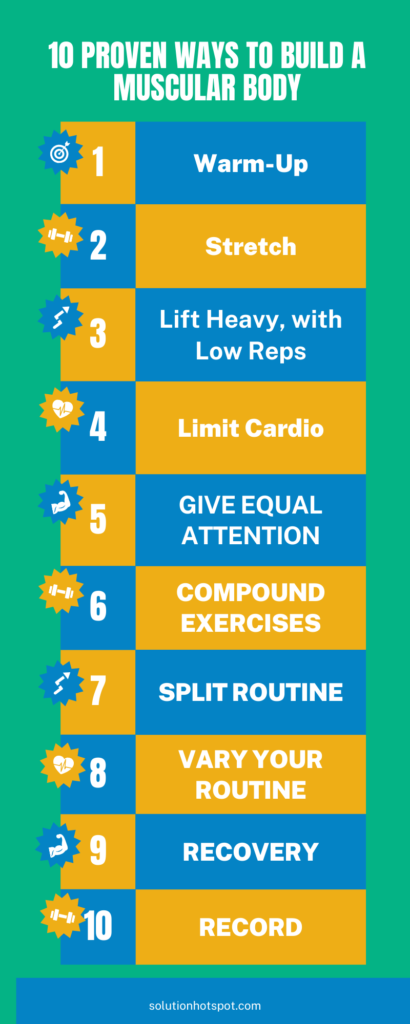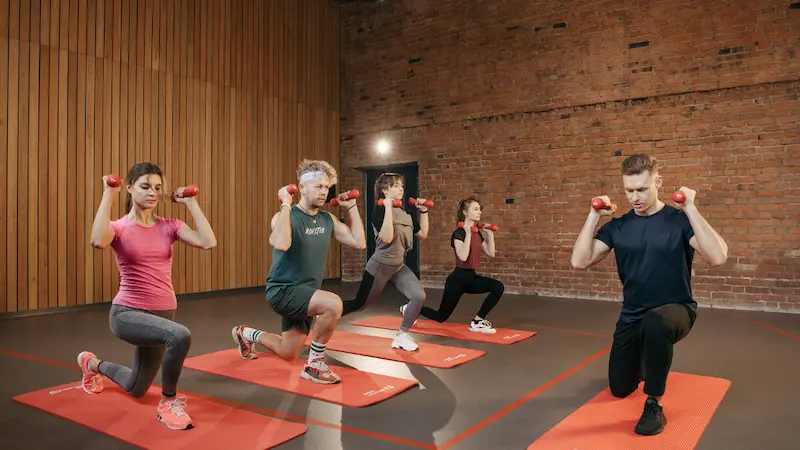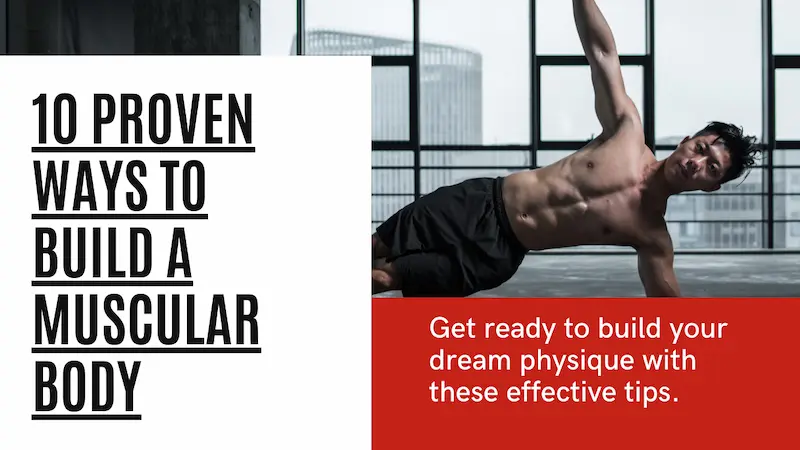10 Proven Ways to Build a Muscular Body: A big muscular body attracts the attention of everyone. It’s an impressive figure to look at. And if you ask any body builder if didn’t just come with magic it took time, and hard work to get them where there at, but most importantly, the knowhow. You can do some random routine for ‘x’ amount of months and years and be left with no results. That’s when these 10 Ways to Build a Muscular Body will lead you to the results you want.


Exercise
1. Warm-Up


The warm up, usually neglected as it’s perceived as a waste of time. But sooner or later you’ll regret it. By warming up it helps the body to loosen up as the blood is adequately pushed throughout the body. Not only does it get you in the mood to pump some iron but also help prevent injury. Begin with a low intensity workout such as, walking or running for roughly 5-10 minutes.
2. Stretch


During the warm-up include stretching. Focusing on the particular body parts you want to work for that session. Stretch for a minimum of 5 minutes however, the longer you give to it the better. Otherwise such ‘cold’ muscles will likely to tear on sudden and heavy movements. And on completion of your session stretch again to reduce the intensity of aching muscle (caused by the buildup of lactic acid).
3. Lift Heavy, with Low Reps


Picking up a light weight that you can do 30, 50, 100 repetitions will do wonders for endurance however, nothing for increasing your muscles. You want to build your body so always go for a weight that is heavy for you yet you can just manage that of 3-8 for each muscle group and compound exercises 6-12 reps per set. With a short break of around 10 seconds between reps and 3-5 minutes between sets. Yes it sounds too short, but that’s all it takes. The last rep should be impossible to complete. If it was way too easy then go heavier next time.
4. Limit Cardio


In the bulking phase (build muscle) limit cardio to only that of warming up. Since, cardio would burn up your energy that can otherwise be used up in weight training. As opposed to the shredding phase (cut fat) where cardio such as running and bicycling is ideal for weight loss. But if you really must do cardio to a strict minimum not more than 3 times a day and that for 30 minutes maximum.
5. Give Equal Attention


So you want to have large biceps, but how about the rest of your body? If ignored, it will look disproportionate. And reason more work out your full body and in turn see a much faster and better results. Be sure full attention is given, to equal number of reps, work on every body part with either compound exercises or a split routine.
6. Compound Exercises


Want to maximize results in shorter amount of time? Work out your full body with compound exercises instead of isolated exercises that only work out one part of the body at a time. 45 minutes maximum a session should suffice for burning fat (to show off your muscle), build muscle and save on time too . So in saying that, here are some compound exercises for each part of the body that you are interested in.
- Biceps: Barbell Rows, Pull-ups
- Chest: Bench Press & Pushups
- Shoulders: Overhead Press
- Back: Deadlifts
- Abs: Planks
- Legs: Squats
7. Split Routine


If you still want to go ahead with isolated exercise get the most out of it with a split routine. This means you can do one session of one part of the body (either upper, lower and core) and the another session with another part of the body. Avoid working out the same part two days in a row giving the muscle in that area sufficient time to repair itself.
- Biceps: Dumbbell arm curls
- Triceps: Dips, Overhead dumbbell press
- Chest: Dumbbells
- Shoulders: Front raises
- Back: Lat pulldowns
- Abs: standard/oblique crunches
- Legs: Leg extensions
8. Vary Your Routine


After sometime of the same routine (it varies from individual to individual) you will notice no improvement (known as a plateaus). The likelihood is that our body has adjusted to this routine that now it need a change. In this case after 3-4 weeks change your rep to give a shock to your body and in turn a positive response. Simply adding more sets just mean extra work that can be avoided.
9. Recovery


Sleep allows the body to recover from the energy lost and repair the tearing of muscle that occurred during weight lifting. 7-8 hours of sleep is most ideal for peak performance in your training sessions and other daily activities likewise.
Furthermore, you need to take at least a day off on working out a body part to recover and repair too. Also giving time for other responsibilities and needs in your life such as family and work commitments. Or else, you could cause an injury or deteriorate the muscle from over-training it. And you could also lose motivation.
- If you are doing compound exercises, take a day off in between. For example, 1st day exercise, 2nd day off, 3rd day exercise, 4th day off, 5th day exercise, 6th & 7th off.
- And for a split routine example. 1st day biceps, chest and shoulders, 2nd day legs, triceps and core, 3rd day biceps, chest and shoulders, 4th day legs, triceps and core, 5th day biceps, chest and shoulders, 6th & 7th rest. Add more rest days if needed just as long as you push yourself during those exercise days.
10. Record


Record everything that you do, your exercise, reps and weight (if applicable dumbbell, barbell or weight training) on a daily basis. In addition, to your body measurements, body part (bicep, chest, waist, thighs and calf) in centimeters and body weight in kilograms. This allows you to consistently reflect and improve on your next session from weeks, to month and years’ time from now.
Note: Beginners should take experienced guidance in person in performing such exercises at first to learn proper form and avoid injury. Something on your mind? Let me know the comments below
10 Proven Ways to Build a Muscular Body
FAQ
Q1: What are the key principles of building a muscular body?
A1: Building muscle requires resistance training, progressive overload, and a proper diet to provide the necessary nutrients for growth.
Q2: How often should I work out to build muscle effectively?
A2: Aim for 3-5 workouts per week, focusing on different muscle groups each session, allowing for proper recovery.
Q3: Can I build muscle without a gym membership or home equipment?
A3: Yes, bodyweight exercises and resistance bands can be effective for muscle building at home.
Q4: What’s the role of nutrition in muscle growth?
A4: Proper nutrition is vital. Ensure you consume enough protein, calories, and a variety of nutrients to support muscle development.
Q5: How long does it take to see noticeable results when trying to build muscle?
A5: Results vary, but you can typically see significant changes within a few months of consistent training and diet.

